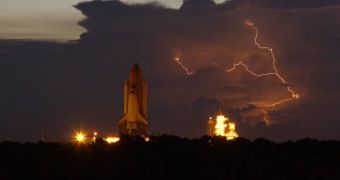A couple of weeks before space shuttles are launched from the Kennedy Space Center, at the Cape Canaveral complex in Florida, they are taken out on a five-kilometer cruise atop the massive, Apollo-era Crawler-Transporter (CT), the second largest tracked vehicle in the world. This giant beast of burden takes the shuttles and the rockets carrying them, set up in launch configuration, to Launch Pad 39A. In the latest such trek, while carrying the space shuttle Discovery on Tuesday, the transporter was forced to move slowly and uncertainly, due to massive lightning storms and rains that made the road difficult.
When on launch pads, NASA's shuttles are protected by extensive lightning masts, as well as by shell-like protective structures, which ensure that no damage is caused even by the most severe storm. However, on the strip of road that connects KSC's massive Vehicle Assembly Building (VAB) to the only launch pad still associated with the Shuttle Program, 39A, the vehicle, shuttle, carrier vehicle and staff are at the will of the elements, as one NASA official plastically put it.
“We had torrential rain here yesterday evening. It rained for hours (...) so it was pretty soggy,” Allard Beutel, a NASA spokesperson talking from the KSC, told Space yesterday. Discovery's roll-out, which had already been delayed by two hours as to avert any lightning strikes near the shuttle or crew, was further made slower by the fact that the CT had to stop fairly often to have its massive tracks cleaned and all the mud removed.
The road to either pad 39A or 39B is not paved, as no type of concrete could withstand the massive weight that the transporter and the shuttle/rocket place on it. Therefore, after a heavy rain, it usually takes some time before NASA allows engineers to take the shuttle out of the VAB. Yesterday's move began at 2:07 am EDT (0607 GMT), when the 5.5-million-pound (2.4-million-kg) crawler started moving. Despite the fact that it usually takes only about six hours to perform the trek, the latest trip took more than 11 hours, which stretched nerves among the crew almost to the limit.
NASA has to launch Discovery, which will carry out the STS-128 (ISS assembly flight 17A) mission, by no later than August 30th. Any later, and the launch schedule will have to be modified drastically, on account of a new Japanese unmanned space freighter launching on September 10th, also to the station. The mission will also replace Timothy Kopra, the new flight engineer of Expedition 20, with NASA astronaut and engineer Nicole P. Scott. Three maintenance spacewalks will repair the European Columbus module, and a number of new experiments will be taken aboard the outpost.

 14 DAY TRIAL //
14 DAY TRIAL //